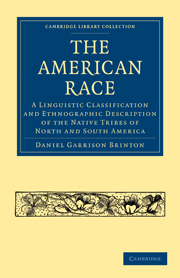 The American Race
The American Race II - THE SOUTH ATLANTIC GROUP
Published online by Cambridge University Press: 29 August 2010
Summary
THE AMAZONIAN REGION
THOSE two mighty rivers, the Amazon and the Orinoco, belong to one hydrographic system, the upper affluents of the latter pouring their waters for six months of the year into the majestic expanse of the former. Together they drain over three million square miles of land, clothed throughout with lush tropical vegetation and seamed by innumerable streams, offering natural and facile paths of intercommunication. It is not surprising, therefore, that we find linguistic stocks extended most widely over this vast area, each counting numerous members. Of them the most widely disseminated were the Tupi, the Tapuya, the Carib and the Arawak families, and to these I shall first give attention.
The Tupis
Along the coast of Brazil and up the Amazon there is current a more or less corrupted native tongue called the “common language,” lingua geral. It is derived mainly from the idiom of the Tupis, whose villages were found by the first discoverers along the seaboard, from the mouth of the La Plata to the Amazon and far up the stream of the latter. According to their traditions, which are supported by a comparison of their dialects, the Tupis wandered up the coast from the south. Their earlier home was between the Parana river and the Atlantic. There they called themselves Carai, the astute, a term they afterwards applied to the Spaniards, but later were given the name Guaranis, meaning warriors, by which they are generally known.
- Type
- Chapter
- Information
- The American RaceA Linguistic Classification and Ethnographic Description of the Native Tribes of North and South America, pp. 229 - 332Publisher: Cambridge University PressPrint publication year: 2009First published in: 1891
